This is our step-by-step guide on how to dehydrate macaroni. Dehydrating macaroni is real easy to do and a great first dehydrator project.
Dehydrating macaroni is a simple process that can help make your camping meals even more enjoyable. By removing the moisture from the cooked pasta, it becomes lighter, takes up less space, and has a longer shelf life. Plus, dehydrated macaroni can be used in a variety of dishes beyond just mac and cheese, making it a versatile addition to your camping pantry or for emergency preparedness.

Even if you’ve never dehydrated anything before, don’t worry – it’s a simple process that anyone can do with just a few basic tools. And the payoff is worth it. With dehydrated macaroni in your pantry, you’ll always have a comforting and filling meal on hand, no matter where the situation takes you.
So, whether you’re a seasoned backpacker or just looking to up your camping meal game or stock your preparedness pantry, read on for our comprehensive guide to dehydrating macaroni.
So, let’s get started dehydrating macaroni pasta.
Table of Contents
- How to Dehydrate Macaroni
- Supplies Needed for Dehydrating Macaroni
- Step 1. Process the Macaroni for Dehydrating
- Step 2. Preparing the Dehydrator for Dehydrating Macaroni
- Step 3. Dehydrating the Macaroni
- Step 4. When is the Dehydrated Macaroni Done
- Step 5. Equalizing and Conditioning of the Dehydrated Macaroni
- Step 6. Storing Dehydrated Macaroni
- Hydration
- Weights, Measures, and Serving Sizes
- Insider Tips
How to Dehydrate Macaroni
There are many macaroni options, from prepackaged mac and cheese boxes to bulk-size boxes and bags.
Our thoughts: we try to multipurpose things, so we chose a good quality mac and cheese product. We can dehydrate the elbow macaroni, and we have a powdered cheese packet to save for other uses.
You can find boxes of mac and cheese in almost any store. That is what we’re using here. Only we’re stepping it up a bit.
You need a good-quality food dehydrator to dehydrate macaroni. We use Nesco food dehydrators. You can check out our food dehydrator guide and learn about why we think Nesco offers the best bang for the buck. We believe this is the best food dehydrator for our long-term food storage needs.
For planning purposes, the cooked macaroni from one 6-ounce box of mac and cheese will fill 2 to 3 of the Nesco FD-61 dehydrator trays.
You’ll also need the removable mesh screen inserts; one is needed for each tray.
Supplies Needed for Dehydrating Macaroni
- A good quality mac and cheese product
- Food dehydrator, with removable mesh inserts for the dehydrator trays
- Standard kitchen tools, including cutting boards, chef’s knife, spatula, colander, etc
- Wide-mouth canning jar funnel
- Clear canning jars with tight-fitting lids
- Desiccant packets
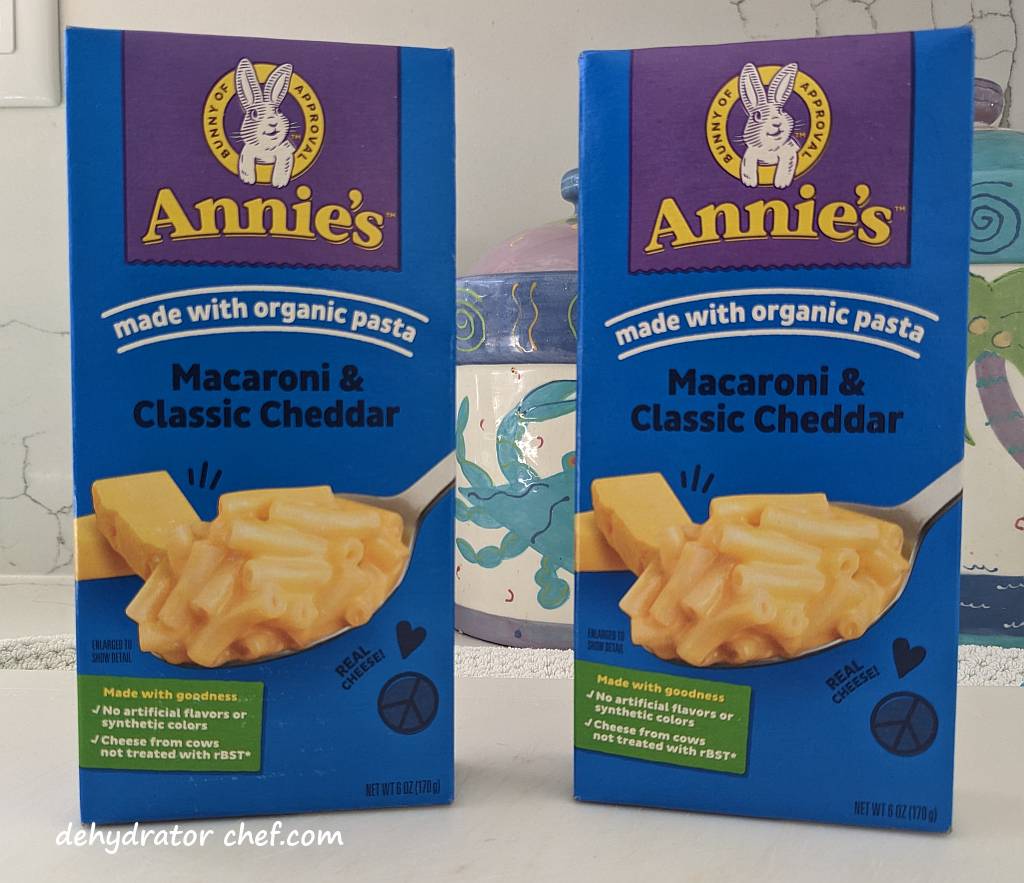
Step 1. Process the Macaroni for Dehydrating
We are going to cook the macaroni according to the preparation directions on the box.
Generally, for a 6-ounce box, bring about 6 cups water to boil water in a saucepan.
Then we stir in the pasta and cook for 6 to 8 minutes, or until done, stirring occasionally.
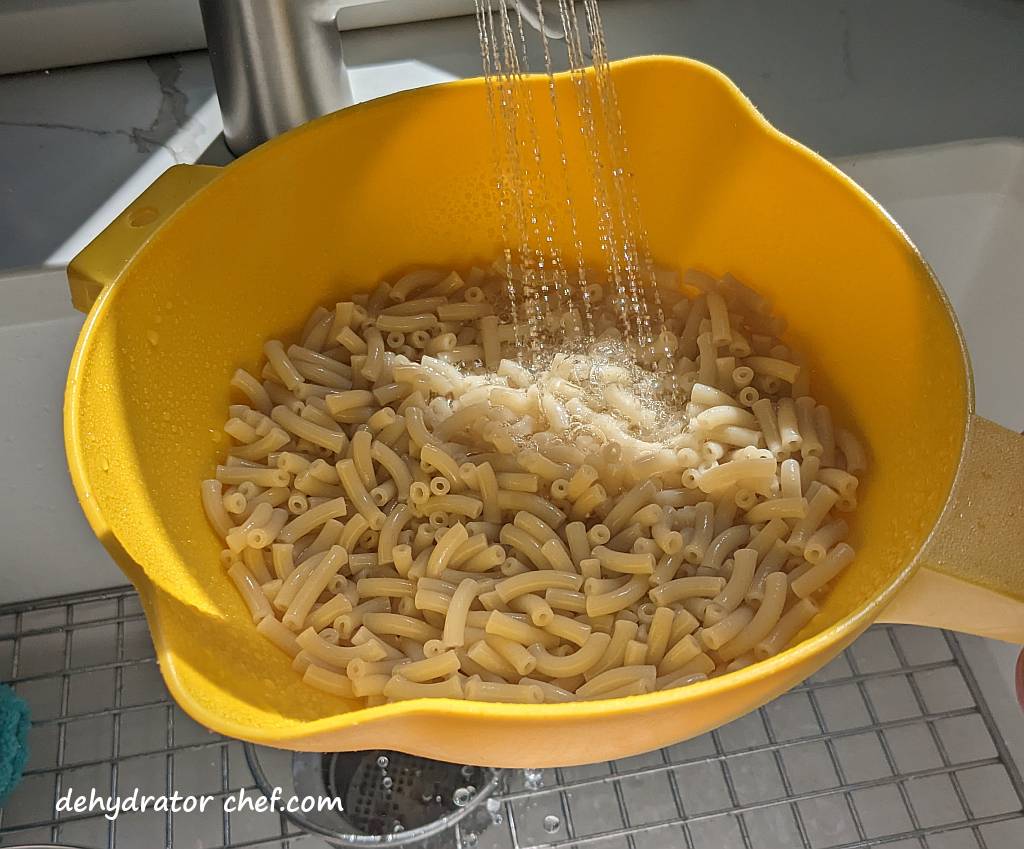
Drain the pasta in a colander. Give it a couple of good shakes to help remove any remaining water.
Step 2. Preparing the Dehydrator for Dehydrating Macaroni

We will use the removable mesh screen inserts with our Nesco FD-61 food dehydrator. They have over 2700 customer reviews with an average rating of 4.7 stars out of 5, which is evidence of a great product. Check out other Nesco food dehydrator products here.

Nesco Clean-A-Screens are removable and flexible mesh screen inserts that have both a distinct top and a bottom side. If you had a high-powered microscope, you would see the individual strands in mesh screens have a triangle shape. The bottom side of the screen feels smooth. The top point of the triangle feels rough as you rub your fingers across the mesh.
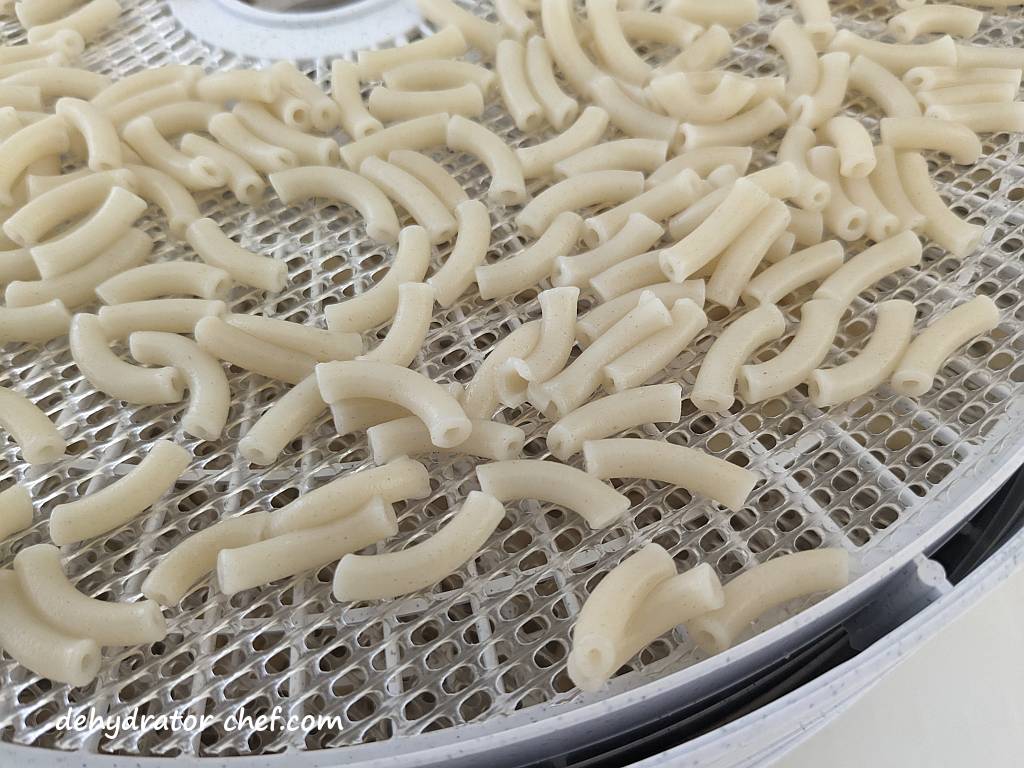
The elbow macaroni from a 6-ounce box of mac and cheese will fill 2 or 3 of my Nesco 13.5-inch round dehydrator trays. I prefer to spread out the macaroni for faster dehydration. In other words, 2 trays will be somewhat crowded, and 3 trays will not.
Step 3. Dehydrating the Macaroni
For elbow macaroni, set the dehydrator temperature to 135 °F / 57 °C. I find that 18 to 24 hours is about the right amount of time for dehydrating macaroni.
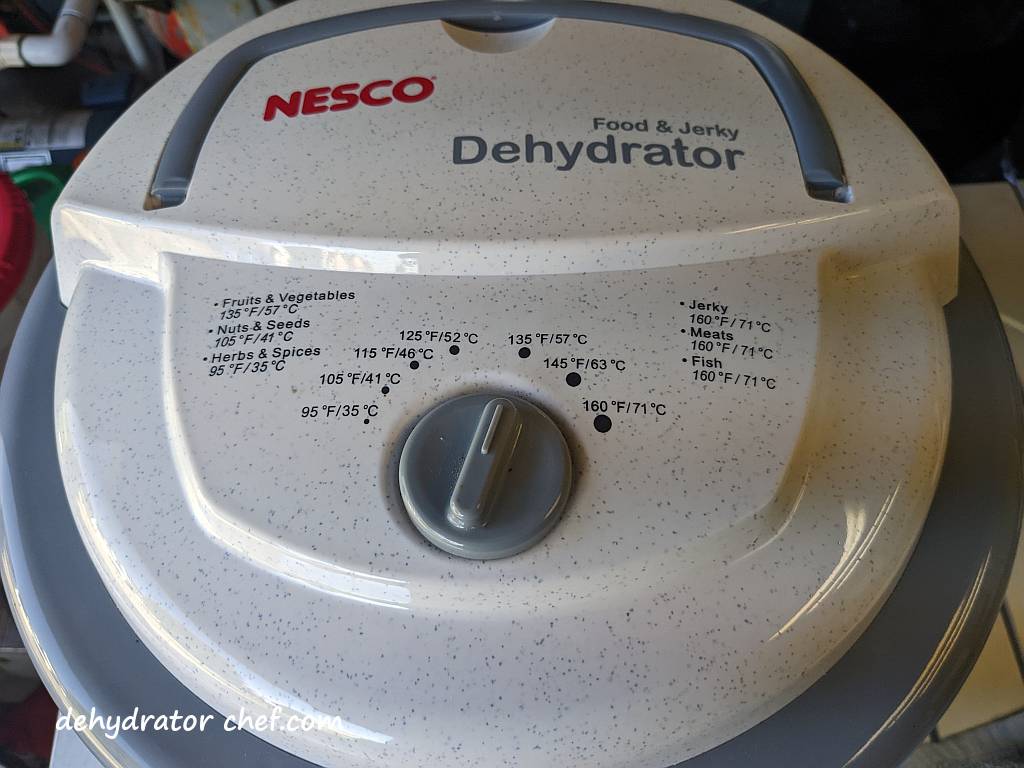
I can boil up a box or two of the pasta from the mac and cheese boxes in the late morning, and they will have finished by the next morning.
The cooked macaroni has a lot of water content. Of course, it’s all dependent on the ambient temperature and humidity and how crowded you fill your trays. Remember to use drying times as a guide.
Step 4. When is the Dehydrated Macaroni Done
After 18 to 24 hours, the macaroni pasta should be fully dehydrated. If not, let it go another 4 to 6 hours and check again.
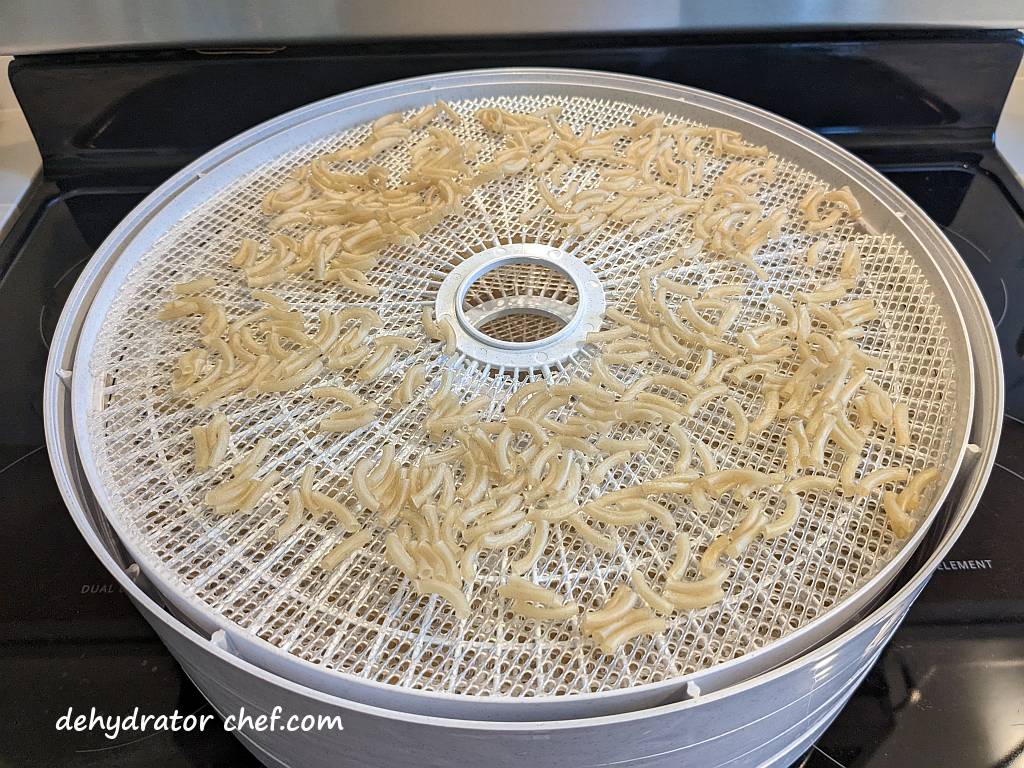
Drying times will vary depending on your dehydrator. Refer to your dehydrator owner’s manual for recommended temperatures and times for dehydrating specific foods. Remember to use drying times as a guide.
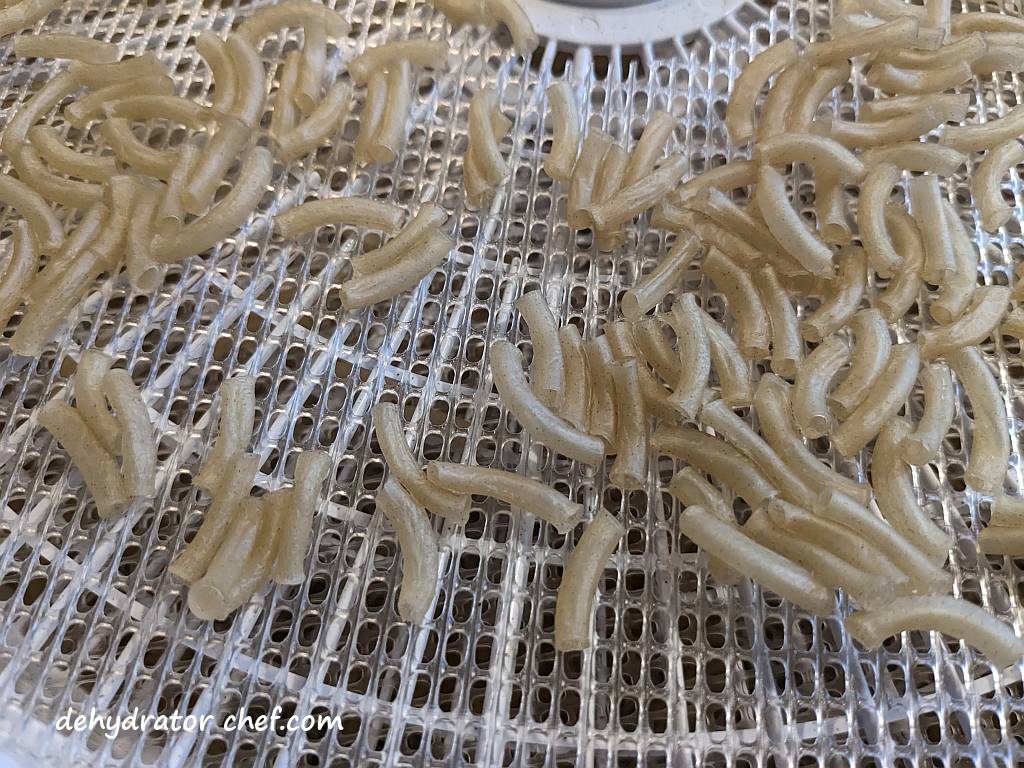
Warm macaroni still in the food dehydrator will feel somewhat tacky, and you may believe they need more drying time. Simply unplug the dehydrator and let everything cool down. Then check again to be sure. The macaroni pieces should easily break apart into individual pieces when done.
Step 5. Equalizing and Conditioning of the Dehydrated Macaroni
We always recommend letting food items cool completely after they have finished dehydrating and before packing them into an airtight storage container for equalizing and conditioning. Warm food may cause sweating, which could provide enough moisture for mold to grow.
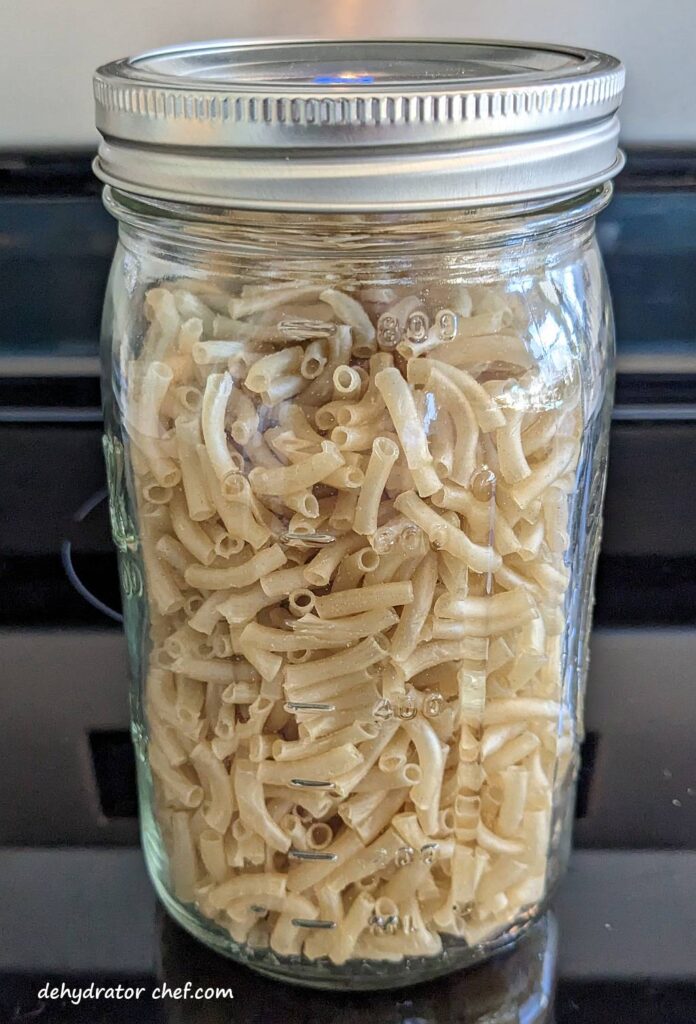
It does not take long for dehydrated food items to start hydrating from ambient household humidity. Do not leave dehydrated food items exposed to the elements any longer than necessary because of the increased risk of mold growth.
After a short cooling period, loosely pack the dehydrated macaroni into a clean, dry, insect-proof, and air-tight storage container. We use the larger quart-size canning jars for conditioning. Since the canning jars are clear, it’s easy to see what’s inside.
A quality stainless steel or plastic canning jar funnel makes the messy job of getting dehydrated foods off the dehydrator tray removable inserts and into the canning jars an easy task. Take a minute or two and check them out on Amazon.
When the dehydrated macaroni pieces are removed from the dehydrator, the remaining moisture may not be distributed equally among the pieces because of their location and position in the dehydrator. Equalizing and conditioning is a process for freshly dehydrated foods that ensures any residual moisture remaining in any piece is spread or equalized among all the other pieces in the batch. Let the dried macaroni equalize and condition in the storage container for 7 to 10 days.
Every day, check the jar for moisture. Roll the jar contents around and note any clumping or sticking. If seen, put the contents back on the dehydrator for several more hours. Since canning jars are clear, it’s easy to see what’s inside.
If you notice any mold at all, even the smallest bit, throw it all out. What you see are the mold spores finally blooming enough to make them visible. But there are more, even tinier mold spores in the rest of your jar that make your dehydrated food inedible. Toss it out and start another batch.
Step 6. Storing Dehydrated Macaroni
Use an appropriately sized canning jar for storage. The dehydrated macaroni might keep up to 12 months. Exactly how long depends on how well you dehydrate the macaroni and your pantry storage conditions.

We’ll use a food-safe desiccant packet for moisture control because we live in a fairly humid area. For our pint-size or quart-size mason jars, we’ll use a single food-safe 5-gram desiccant packet. The desiccant packets will absorb any moisture and extend the shelf life of the macaroni.

We use these inexpensive food-safe desiccant packets, which are available from Amazon. These 5-gram packets have over 5000 of mostly 4- and 5-star customer reviews, with an average of 4.7 stars out of 5. Our bag of 60 desiccant packets will last quite a while because they can be recharged and reused multiple times. Other food-safe sizes are available.
Lastly, I’ll attach or include a short note describing the jar contents and the date the product was dehydrated. The note also lets me know where to go in my dehydrator logbook if I want to make another note or two.
Hydration
Hydrate the dried macaroni using a 1-to-1 ratio of dehydrated macaroni to boiled water. Plan on at least 15 to 20 minutes to fully hydrate.
If you’re supplementing store-bought freeze-dried meals as we often do, just add a bit more boiling water to the food pouch. Use the same 1-to-1 ratio of dehydrated macaroni to water and account for the extra time. I find that most store-bought freeze-dried meals could use a little extra to bump up the calorie count.
Optionally, hydrate the dried macaroni separately and then mix.
Weights, Measures, and Serving Sizes
This information is from a recent entry from the notes we keep on most of our food dehydration efforts.
We used 2 of the 6-ounce boxes of Annie’s Macaroni & Classic Cheddar made with organic pasta for this project.
The 2 boxes of cooked macaroni filled up 6 of the Nesco FD-61 dehydrator trays. I probably could have gotten away with using 5 trays.
The nutrition facts showed there were about 2.5 servings per container. We’ll round this down to 2 servings.
The uncooked macaroni weight was 131 grams.
Cooked and drained, the macaroni weighed 389 grams.
After dehydrating for 20 hours and then cooling for 30 minutes, the weight was 115 grams.
Wow, that’s interesting! The dehydrated macaroni now weighs less than what comes from the box!
So, 1 serving of dehydrated macaroni would be approximately 60 grams.
Insider Tips
Besides dehydrated meal recipes found here on this website, add dehydrated macaroni to any of your favorite freeze-dried food pouches for a bit more bulk and calories. I don’t know about you, but with some of those store-bought freeze-dried meals, I am still hungry. I need a bit more to fill me up.
Just be sure to compensate by adding additional boiled water in a 1-to-1 ratio to the freeze-dried meal and allow enough time for adequate hydration. Or just hydrate the dried macaroni separately.
Dried macaroni will easily hydrate with cold or warm water. It makes for a great pasta salad.
Practice at home making dehydrated camping meals using the very same gear used in the field. We practice reinforcing the skills we have learned. Practice makes perfect.
